Note: this post originally appeared as a blog arc on my old Triquatrotiticale blog. I’m resurrecting the complete arc here as it’s referenced in That Think You Do‘s “The Liz Effect” chapter
Enjoy!
For those of you who weren’t in the loop, NextStage has been taking it’s desktop tools and turning them into web tools. The first to come out of that particular shute is NextStage’s Sentiment Analysis Tool. I’ve written about that tool before in Sentiment Analysis, Anyone? (Part 1) (happy to resurrect, if you wish) and Canoeing with Stephane (Sentiment Analysis, Anyone? (Part 2)) (ditto). Here I’ll be sharing how to use and understand the Level 1 version of that tool.
NextStage’s Level 1 Sentiment Analysis tool provides the following information (per our then CEO):
- Love Factor – This report will provide an horizontal histogram composed of 3 items: Positive, Neutral and Negative. It will thus show on a scale from 0 to 100 the positive, neutral, or negative degree of the message. As in real life, things aren’t black or white we expect that any message will score in the three dimensions but at different levels.
- BS Meter – This report will present a gauge with a scale from -100 to 100 with shade of colors ranging from red to yellow and to green. It will present if the author of the analyzed text believes (actually, whether or not the author is confident in what they’re writing) or not what he has written and to what extent. We believe that a score over 25 means that the author believes what he’s written and under -25 the opposite. In between, the author is not really sure
- Message retention Probability – This report will present in a gauge in a scale from 0 to 100 the probability that the conveyed message will be retained by the readers of this message. It is stated as a probability as this will depend upon the type of visitor reading the text (it’s Rich Persona) and it will be reported against the whole population of our Synthetic Users.
- Message intent – This report will provide an histogram composed of 5 items: Referral, Retribution, Love, Constructive and Troll. It will thus show on a scale from 0 to 100 the intention of the message for each of these items. The same consideration as for the first report applies (non Black or White).
- Author Influence type – This report will provide an histogram composed of 3 items: Influencer, Gatekeeper and Hub. The scale will go from 0 to 100 and will present the type of author that has written the text.
As always, I’ll use my own writings for demonstration purposes in the beginning. The reasons for this are simple:
- the NextStage Sentiment Analysis tools are reporting on the non-conscious of the author when that author was composing the information.
- I’ve had several dozens of years of training to recognize, understand and report on my own non-conscious activities and behaviors hence will be able to describe whether or not I believe what NextStage’s Sentiment Analysis tools are reporting.
I’ll analyze some other online material (again, for demonstration purposes) once I’ve analyzed a few of my own (let me know if you’d like something you’ve written analyzed).
You Found It!
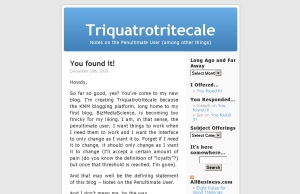
Let’s start with the first Triquatrotritecale post, You found it! (tritto). What is there now isn’t what we original had (the original is shown above and we’re still working on it). But what did that original post have to say about me when I wrote that post? What say we find out.
-
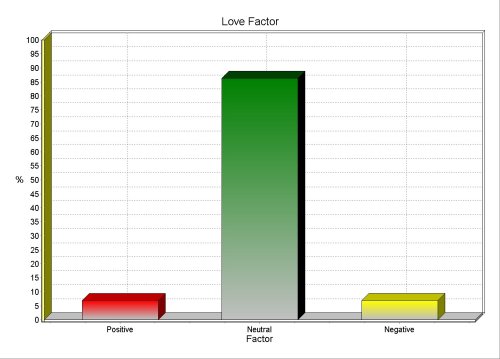
Love Factor – First you need to know that I’m a stickler for accuracy. I’m very uncomfortable with (what I call) marketing truth, the tendency of people to put their spin on things so that what is horrible doesn’t sound so. Example: President Obama’s stating that the Copenhagen accord was “Meaningful and unprecedented.” Both are true and I’ll concede that both are accurate. I’ll also offer that neither are accurate truths. It’s kind of like a sin of omission mixed with caveat emptor and some it’s what you don’t know that’ll hurt you thrown in. One of our NextStageologists chides me that I’ve become very good at marketing-speak and it wounds me, truly. Or accurately.Accuracy versus truth comes into play with the Love Factor chart above. You see that the Neutral reading is high compared to Positive and Negative, yes? That’s true and not accurate. Human beings are not naturally “neutral” to much of anything, not non-consciously anyway. What NextStage’s Evolution Technology (ET) really recognized was that my Positive reading was about 52 points and my Negative was about 48 points. The truth of this is that I was working at being neutral. To most people it would come off as neutral and only because the conscious brain takes the non-conscious information “He’s working at being neutral” and mentates “He’s neutral”.
My position (ahem) is that there’s a lot of difference between someone working at being neutral and truly being neutral. Susan and Charles disagreed with me. More accurately, they agreed with me and also offered that the subtlety would be lost on most people (I think better of you, dear readers, than do they).
The accurate truth is that my Positive value was 210, my Negative was 192.5, my Neutral somewhere around 20. These values indicate that while I was working at being neutral, I wasn’t really busting my gut over it, more like I was just another human being being human.
But in any case, NextStage’s Sentiment Analysis tools will report something like you see above unless the Positive and Negative values are “arithmetically” different, meaning the author recognizably writes one way or the other.
-
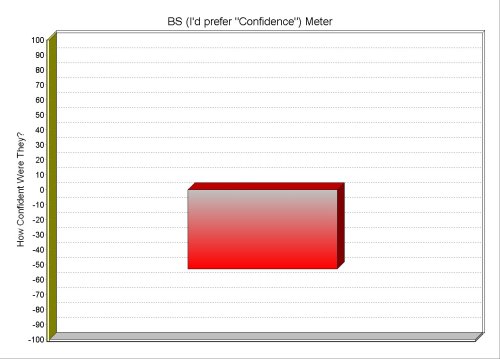
BS Meter – First, I’ve never been comfortable with the term “BS” or any of its variants. Also, what NextStage’s Sentiment Analysis tools measure is whether or not the author non-consciously believes (“accepts” is a more accurate term) what they’re offering as being valid information. Most accurately, ET takes a reading of whether or not the author is confident in the information they’re providing then matches that to some other things and the result is a measure of their confidence in what they’re writing.The distinction may seem subtle and I assure you it’s not. That distinction is shown on the above chart. What I wrote in You Found It! was quite true and accurate.
But (!!!) I really didn’t have any idea where this blog would go or what I would post about when I wrote You Found It!, hence my confidence in what I was writing wasn’t as good as it could have been. For that matter, I wrote in I’m the Intersection of Four Statements (quinto) “I consider myself one of the least confident people I know.” so my confidence levels should never be incredibly high.
What can be gleaned from this metric is that when the author (yours truly) wrote that post they definitely were uncomfortable with the information they were presenting. The value (-52.81) indicates a probable lack of confidence in what they were presenting. Was it BS, though? I suppose that depends on what the person reading the charts thinks of the author. Neutralizing that “person reading the charts” bias is a lot of what NextStage trainings are all about (just an FYI, folks).
-
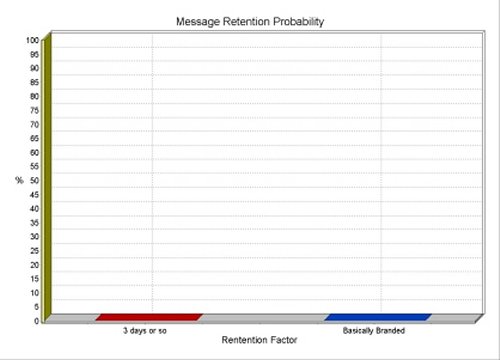
Message Retention Probability – This is another metric which can be true, accurate or both. The image on the right is about as true and accurate as I can mathematize them. What’s showing is this: Taking the greatest population swath possible, basically 0% will remember what I’ve written.This is both true and accurate. Especially if you know what’s being calculated.
Knowing only what is written and nothing about who is reading, the writing style I use and topics I write on suit such a small audience that when measured against the entire blog-reading population, I basically write for 0% of the population (the other truth involved in this is most people don’t know how to write or design information for the largest possible audience. This more than anything else is why most websites are thrilled to get 3% conversions, why companies have to practically hit you over the head before you can remember their brand and act on it in any meaningful way, …).
However, my regular readership retains about 90% of what I write. This isn’t to suggest that everything I write is understandable, only that it’s easily memorable.
Have you ever seen my blog traffic numbers? Trust me, we’re talking a very low percentage of the general population.
So, if the question is “what percentage of the general population will remember what I’ve written?” the answer is 0%. If the question is “what percentage of my readership will retain what I’ve written?” the answer is 89.25%.
The only way I know of to answer that last question, though, is if you have NextStage’s OnSite tool tracking your site. That’s a description of the limits of my knowledge, not a plug for NextStage technology.
So we can resort to something that is either true or accurate and both depend on how fine you want to cut things. For example, if you’re not interested in the tightest possible segmentation, my writing (or at least that one post) would be memorable to just under 17% of the general population. That’s true but not accurate because of how the brain retains information. Information (such as a webpage) may be presented visually (for example) and it will not necessarily be remembered (think of how much you see in a day — heck, in a minute — that you can remember seeing three days — heck, three hours — later); Information has to be presented in a way that is both stimulating (to lock attention on it) and memorable in the way that the greatest percentage of the population remembers information.
Or presented as you know your audience will remember it (read “configured so that both brain and mind assign high enough “survival” value on the information that said information is quickly placed in deep or ‘long term’ memory”).
So the question becomes, do people using NextStage’s Sentiment Analysis tools want things true, accurate or both. We can do them all…oh heck, why not just do them all and have done with it?
By the time we release these tools to the general public this particular report will provide true, accurate and both true and accurate results. Let me go do that now, in fact…
(about half an hour goes by)
Okay. This report will now (“now” meaning as soon as our programmers convert my math into working code. They’re very good at it. It’ll take them less time to get it installed and working than it took me to mathematize it) show “Understand But Not Remember”, “Remember But Not Understand”, “3 Days or so” and “Basically Branded”.
(and I hope you all appreciate what I do for you)
-
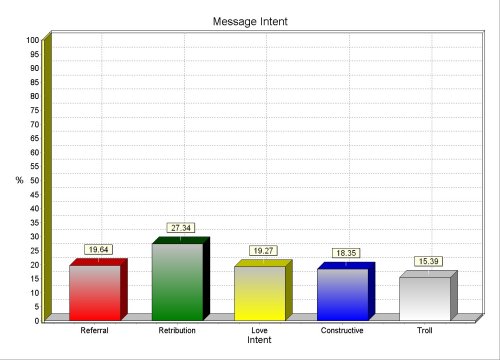
Message Intent – This, thank goodness, is a fairly straightforward report to apply. What is shown here is that a) your author is pretty mild-mannered over all (the numbers are kind of equal) and b) wanted to get back at someone or some thing (the Retribution value). In this case, it was the KMM blog platform and for reasons I made obvious in both You found it! (sexto) and Today I was asked if I was comfortable doing NeuroEngineering (septo). The Referral, Love and Constructive values being pretty close to each other hearkens back to the “working at being neutral” versus “being neutral” thing mentioned above. -
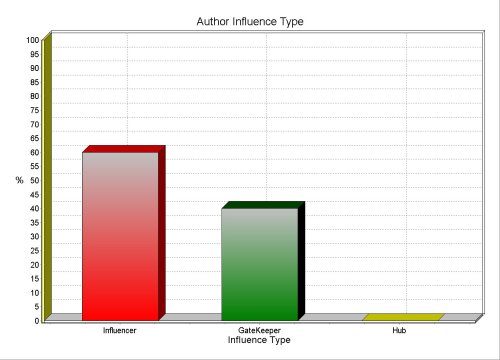
Author Influence Type – This is a metric that one needs to understand clearly. NextStage’s Sentiment Analysis Tools are metricizing whether or not and how much the author believes they are an Influencer, a GateKeeper and a Hub. This is not an indication of how their readership thinks of them, only how the author thinks of themself (learning what an author’s readership thinks of the author would require NextStage’s OnSite tool or something similar).The results for this post did surprise me (and remember, this is a non-conscious metricizing of myself). Consciously I don’t think of myself as either influencer or hub. I would accept having a GateKeeper mentality and recognize that would be my boundaries and limits (“boundaries and limits” as in personal boundaries and personal limits. Most everyone who knows me tells me mine are incredibly strong).
But then I thought about it. According to Twitter I’m either influential or highly influential. This information amazed and baffled me. People take me seriously? People think I know what I’m doing? Wow.
Even so, not knowing how Twitter comes up with such definitions I had trouble accepting it (although it was flattering). But then several conversations over the past months revealed what some people are calling The Joseph Effect. People want to emulate my methods and principles in their lives (very flattering). One person told me that they were actively promoting The Joseph Effect in their life and the change has been recognized by others as both growth and positive. Okay, more than one person made such a comment to me. Several, in fact.
This is truly incredible to me. Get to know me better and your attitudes will change, I’m sure.
However, all that stuff had obviously been roiling in my non-conscious for a while. Whether I consciously accept it or not, I non-consciously recognize that I influence people.
And then I remembered debating for a good hour or so whether or not to make “public” that Susan and I donate to what we consider good causes. This was a real debate for me, the intersection of “Let your light so shine (don’t hide your light under a bushel)” and “Don’t let one hand know what the other is doing”. I finally decided that publishing our involvement might cause others to become involved hence I had concluded I was an influencer even though there was no conscious recognition of “I’m an influencer”.
Le coeur a ses raisons que la raison ne connait pas. (Pascal)
And no scarier a thought could one have on a sunny Tuesday afternoon.
But what about what I wrote, forgetting the webpage part?
I demonstrated in Sentiment Analysis, Anyone? (Part 1) (octto) that there’s a difference in what someone writes/designs and how all the blah-blah of the web interface shows people. Think of it as an equation:Informationwritten + Informationweb interface = Total Presentation
The above was all for the Total Presentation shown in the webpage snapshot I shared close to the beginning of this post. What’s the Sentiment Analysis for just the written text?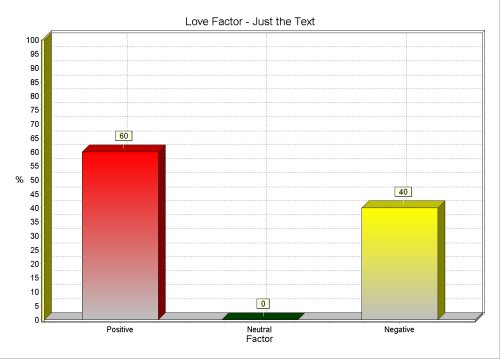
For one thing, once the mitigating influence of the page interface is removed, my truer feelings reveal themselves. Why such a substantial difference with the interface and without? Because I used colors and phrases (for the right column in the blog) that tend towards neutrality rather than offense or defense.That brings us to the Confidence (BS) meter. I won’t bore you with another picture. The original was -52, the pure text value was -51. No matter how you cut it, I’m a very cautious person.
Pretty much the previous result holds true for the revised Message Retention Probability metric. The general public will not understand nor remember what I’ve written for any period of time. Remember, that’s the general public. Perhaps we need to include the option of the tool user entering an audience from a pick list? Anyone? Of course, that might merely prove that not only can the author not write, the person running the test has no clue of what audience the author is targeting. On the other hand, if you’re in charge of marketing for a company blog, you’d have a great idea of who the audience is.
This would be incredibly useful in determining who’d be best suited to write content. Take the naked webpage and plug in some content (3-4 pieces should be enough) from as many authors as you like. Run a test on each set. The author that scores the best with the desired audience is the one who should be writing your content.
Yeah, I like that.
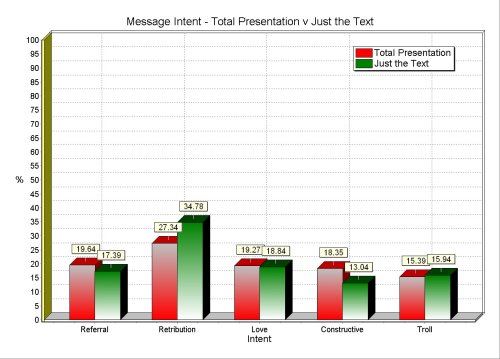
Next on the list is Message Intent. Here I show both “full presentation” and “just the text” values side by side. It’s intuitively obvious to the casual observer and a well known fact among all my regular readers that I love you I love you I love you and it doesn’t matter whether an interface is used or not. In the case of this post, I care about each and every one of you equally (ahem).Equally interesting is the rise in Retribution. Strip away the interface and I was one unhappy camper.
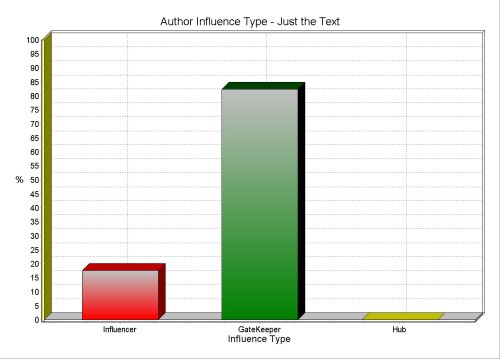
And when you strip away all the artifice of the interface? As I wrote earlier, I’m a GateKeeper. Anybody who’s asked me to share someone else’s personal, private or similar information knows NextStage Principle #51 takes affect.Okay, enough for now. I know there are beta testers waiting to play. If you haven’t heard from our staff or me yet you will in a few days. Or email one of us and let us know you’d like to play.
Next time out, an analysis of some other folks’ blog posts (let me know if you’d rather I not analyze your blog).
And before I forget
I’m writing this post because of my firm belief that people need training when encountering new tools (decto) (at least I require training…”require”? I actively seek it out). Susan suggests a mindset of “We’re not in Kansas anymore” crossed with Friendship Bread when using NextStage tools because our tools measure things that go “bump in the night” as far as most people are concerned and definitely are different from clicks, pageviews, cookies, …<SUSANISM>
Have no fear NextStage will offer plenty of training opportunities and lots material when the next level is ready.
</SUSANISM>
